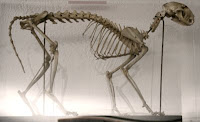 |
skeleton - photo by Sophie. This is a cropped image.
Let's start with the foundation of all mamals, the bones. Here is a picture of a mounted cat skeleton. A cat's skeleton has 290 bones (humans: 206).
Let's start with the foundation of all mamals, the bones. Here is a picture of a mounted cat skeleton. A cat's skeleton has 290 bones (humans: 206).
Maybe a good place to start with cat anatomy is at the front. The cat has a strong bite as some of us have been made aware by experience. The two large and strong muscles in the head that operate the jaw are the Masseter and Temporalis. The same muscles are present in a human. Both muscles are for mastication (chewing).
Recent research indicates that the smaller an animals' brain the stronger the bite, as a general rule, there is more room for larger muscles. This probably explains why the domestic cat has a stronger bite than the human. This fact does not mean that the cat is not intelligent. Less ability in terms of reasoning, yes, but more in other forms of intelligence such as spacial intelligence and senses. Adult cats have 16 teeth on the top jaw and 14 on the bottom.
Paws & Claws Cats have 5 toes on the front paws and 4 toes on the back paws. This is written into cat association breed standards as cats can sometimes have more toes (up to 7 but the Guinness Book of Records records a cat with 27 toes!) than the regulation number. These are called Polydactyl cats or Hemingway cats after the cats kept by Ernest Hemingway whose cats were all of this kind.
Hemingway's home in Florida is a museum and the descendants of his cats still roam the grounds. There are apparently 60 cats, 30 of which are Polydactyl.
These are not a special breed of cat just cats with more toes than normal due to a congenital physical abnormality. Humans can have more than five fingers or toes so this condition cuts across species.
There are 6 separate pads on each paw. Cats paw pads contain sweat glands. The primary reason for a cat to secrete sweat from her/his paw is to improve traction (adhesive friction) between the paw pad and the surface. It helps prevent the pads from slipping on certain surfaces. When a cat is nervous (for example at a veterinarians) she'll sweat from her paw pads. You'll see the paw prints on the vet's table. This happens as the cat is preparing to run! We sweat when we are nervous too (clammy hands waiting for an interview, for example).
Many animals have claws, which are used for digging, climbing and added traction when running (like spikes on an athlete's shoes). In cats, claws have added value by helping the cat to catch and hold on to prey. Claws also are weapons in self defense. They are sickle shaped and very sharp at the tip. They renew themselves to help keep them effective and can be withdrawn into a pouch to protect them when not required (i.e. give them a longer life).
Many animals have claws, which are used for digging, climbing and added traction when running (like spikes on an athlete's shoes). In cats, claws have added value by helping the cat to catch and hold on to prey. Claws also are weapons in self defense. They are sickle shaped and very sharp at the tip. They renew themselves to help keep them effective and can be withdrawn into a pouch to protect them when not required (i.e. give them a longer life).

No comments:
Post a Comment